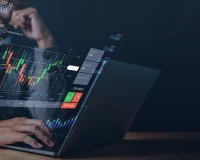-Introduction:
The Forex market (foreign exchange) is one of the largest financial markets in the world, where foreign currencies are traded daily with a massive trading volume reaching trillions of dollars. With the advancement of technology and communication tools, individual traders can now enter this dynamic market and manage their investments effectively. Many trading strategies focus on fundamental and technical analysis, but with the rapid progress in financial technology, quantitative trading strategies have gained significant importance in the world of trading.
Quantitative analysis relies on using data and mathematical models to understand and predict price movements in the Forex market. This article provides a comprehensive overview of quantitative trading strategies in the Forex market, discussing how algorithms and mathematical models are used to make precise trading decisions. We will also address the advantages of these strategies and the challenges traders face in implementing them.
In light of the growing importance of quantitative analysis in financial markets, this article reflects the transformation taking place in trading methods, focusing on leveraging big data and advanced technologies to improve traders' performance and increase success opportunities in the volatile Forex market
-The Evolution of the Forex Market and Its Importance:
The evolution of the Forex market represents a significant chapter in the development of global financial markets, as this exchange has undergone important changes over the decades. In ancient times, currency trading was limited to large banks and financial institutions, but with technological advancements, the Forex market opened its doors to individual traders. This global market offers investors the opportunity to engage in currency trading effectively, allowing them to diversify their portfolios and capitalize on available profit opportunities. A trader’s success in the Forex market depends on a deep understanding of global markets and a precise analysis of the economic and political factors influencing currency movements
-The Role of Quantitative Analysis in Trading:
Quantitative analysis in trading represents a modern science rich with techniques and methods aimed at gaining a better understanding of financial market behavior and making data-driven trading decisions. This approach allows traders to use algorithms and mathematical models to analyze vast amounts of data and uncover patterns and trends in price movements. Quantitative analysis also contributes to better risk management and portfolio diversification, enhancing traders' performance in a complex and dynamic trading environment. By using quantitative techniques, traders can benefit from precise information and comprehensive market analysis, thereby increasing the chances of success and achieving superior performance in the financial trading world
-Quantitative Trading Strategies in the Forex Market:
Quantitative trading strategies in the Forex market are a modern approach that relies on using data and mathematical models to make precise trading decisions. Quantitative analysis gives traders a deeper understanding of market patterns and better analysis of currency movements. These strategies involve the use of complex algorithms that analyze large amounts of data instantly, enabling the identification of trends and trading opportunities. These strategies also rely on the development of mathematical models that simulate market behavior and assist in predicting future changes. These models can be used to determine entry and exit points, as well as setting stop-loss and take-profit levels.
One of the main advantages of these strategies is decision accuracy and time efficiency in trading, as quantitative analysis can leverage big data more effectively than traditional technical analysis. However, the use of these strategies requires a deep understanding of statistical analysis and programming, which makes them generally more accessible to experienced traders in the field of quantitative analysis

-Advantages of Using Quantitative Trading:
Scalability: Traders typically use no more than 5-7 analytical tools at a time, including simpler tools like trend tracking or moving average crossovers. High-frequency trading can, by default, incorporate an unlimited number of strategies and inputs, ranging from classical mathematical analysis methods to behavioral bias studies. The only limitation is computing power, but even retail investors can access quantitative analysis using dozens of analytical tools.
Unlimited Diversification Opportunities: Quantitative analysis is suitable for any market. In currency trading, optimal capital distribution is the most important aspect to reduce risks.
Minimal Error: Statistical arbitrage involves using highly precise data. To recognize an algorithmic pattern and build a forecast based on it, the computer works with hundreds of different parameters, with precision reaching up to a tenth of a thousandth, and sometimes even higher. As a result, calculation errors can be minimized.
Speed of Decision-Making: High-performance computing allows for quick decision-making in trading. This is especially important when trading on shorter timeframes
-The Need for Quantitative Trading:
With the increasing popularity of forex trading, the efficiency of "manual" market analysis is steadily declining. As a result, many hedge funds have long shifted from traditional trading to quantitative trading. Quantitative trading becomes essential when a trader wants to diversify their asset portfolio as much as possible. In traditional trading, you can track, analyze, and trade a few dozen instruments at most. Through the application of quantitative trading, investments can be made in hundreds of assets, as the automated execution mechanism allows you to run multiple trading strategies simultaneously

-Strategies for Quantitative Trading in the Forex Market:
Technical Analysis: This type of analysis uses charts and technical indicators to study price movements, trends, and patterns. Quantitative traders can use algorithms to automatically implement specific technical analysis strategies.
Fundamental Analysis: This type of analysis uses economic, political, and social factors that affect the value of currencies. Quantitative traders can use both quantitative and qualitative data to identify gaps and discrepancies between currencies and capitalize on them.
Quantitative Analysis: This type of analysis uses advanced mathematical and statistical models to analyze the market, search for trading opportunities, and determine strategies. A quantitative trader creates an algorithm that optimally allocates capital and maximizes profits
-Challenges of Quantitative Analysis in the Forex Market:
Despite the clear benefits of using quantitative analysis in the forex market, it faces technical and philosophical challenges that require deep understanding and advanced experience. One of the main challenges is processing and analyzing large amounts of data effectively. Forex generates huge amounts of data in short periods, which requires advanced techniques to store and retrieve it. Market volatility and sudden currency fluctuations present another challenge, as some geopolitical or economic events may be unexpected and significantly impact markets. Other challenges include understanding the interrelationships between multiple variables, which can change rapidly.
Additionally, traders who rely on quantitative analysis face challenges in understanding and evaluating the mathematical models used. Changes in market behavior may require constant updating and adjusting of the models, necessitating a professional and specialized team. In general, it seems that quantitative analysis in the forex market requires a balance between technological innovation and a deep understanding of financial markets to overcome these challenges

-A Look at the Future of Quantitative Analysis in Trading:
The outlook for the future of quantitative analysis in trading predicts significant progress and increased integration with advanced technologies. There is a growing trend toward the use of artificial intelligence (AI) and machine learning in analyzing financial data and forecasting price movements. These technologies will enhance the ability to process large amounts of data more effectively and use predictive models to analyze market behavior. It is expected that the focus will increase on developing advanced mathematical models and sophisticated algorithms to analyze data more accurately and improve forecasting precision.
Quantitative analysis techniques will be more deeply integrated into decision-making processes in trading, where algorithms can be designed to make automatic decisions based on multiple variables. Additionally, interest in quantitative analysis is likely to grow in the future as investors' understanding of the benefits of this approach improves, along with the increased availability of technologies and tools used in this field. The rapid advancements in financial technology indicate that quantitative analysis will continue to play a significant role in enhancing traders' performance and their understanding of financial markets in the future.

-Conclusion:
It is clear that quantitative analysis has brought about a significant transformation in forex trading. Through the use of mathematical techniques and complex algorithms, traders are now able to gain a deeper understanding of market patterns and make more precise trading decisions. The ability to analyze vast amounts of data and use mathematical models marks a major advancement in improving portfolio performance and achieving more accurate results.
In the future, we expect the development of quantitative analysis to accelerate, with the sector seeing further integration with advanced technologies like artificial intelligence and machine learning. Traders will benefit from enhanced effectiveness in analyzing big data and better forecasting price movements, increasing their chances of success in the volatile forex market.
As these developments continue, traders must continue to enhance their skills and stay updated to adapt to the dynamic changes in the forex market. Undoubtedly, the bright future of quantitative analysis reflects a commitment to improving our understanding of financial markets and enhancing our ability to make smart and informed investment decisions.










